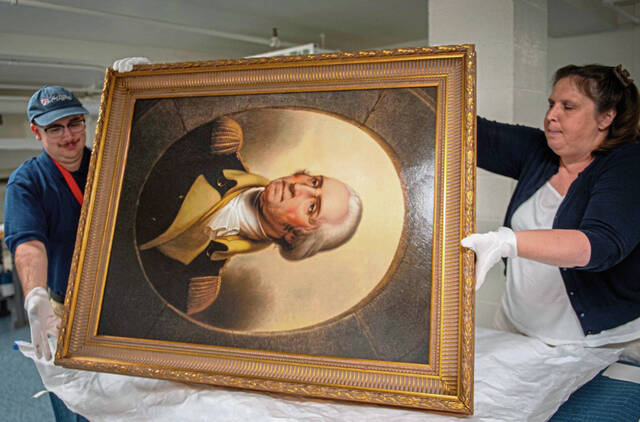https://triblive.com/local/westmoreland/18th-century-artifacts-get-room-with-a-view-at-fort-ligonier-museum/
18th-century artifacts get room with a view at Fort Ligonier Museum

A place for everything and everything in its place applies equally to spontoons and shards.
Thanks to a new climate-controlled collections storage room in the basement of Fort Ligonier Museum, Meghan Budinger will have separate compartments to safely archive the former iron and brass weapon — a type of personal spear — and the latter small fragments of historic ceramic pieces.
“Iron needs very low humidity or it will rust,” said Budinger, the fort’s collections manager. “With ceramics, it doesn’t matter. Moisture isn’t going to hurt it.”
The museum’s more than 100,000 18th-century artifacts will be housed among six cabinets that already are in place and four others that are on order — including one designed to hold muskets and other period weapons.
The waterproof, fireproof cabinets are manufactured by a company that originally made storage compartments for U.S. submarines, according to Budinger.
“If you dropped them in the ocean, they would float,” she said. “We try to store only one type of material in each cabinet because each kind of material requires a different environment.”
Framed art and period garments and documents also have their specific spaces in the collections room.
“Before, we didn’t have a space to take things off display,” Budinger said of the garments. “Now we can rotate the collections out.
“You have to take these pieces off display every once in a while. They need time to lie flat, and they need time in the dark. It really helps with the preservation.”
Creation of the collections room and related improvements to the museum’s basement represent an investment of about $150,000, with support from individual donors and foundations. It’s the final part of a series of major upgrades to the historic French and Indian War site that included the addition of a history education center in 2017.
Many of the items in the Fort Ligonier collection will never make it into public display cases at the museum.
“We’ve got a lot,” Budinger acknowledged. “Most museums have an enormous collection that never goes on display.”
That overflow collection was shipped off-site in 2012 and most recently was held in warehouse space rented from the Heinz History Center.
With completion of the museum’s collection room, those items now are back where they belong, more readily accessible to the Fort Ligonier staff and to visiting researchers.
“Having the collection back under one roof is just phenomenal,” said Fort Ligonier Executive Director Mary Manges. “We can be monitoring it closely for conservation needs and any kind of care.”
Having the collection housed elsewhere was fortuitous in June 2018, when flooding inundated areas along the Loyalhanna Creek and sent water pouring into the museum’s rear basement doors.
“It was a once-in-500 years flood,” recalled Julie Donovan, director of marketing and public relations at the fort. “Since then, there’s been extensive engineering and remediation” — including installation of flood doors and a floodgate designed to hold back any rising water at the museum.
The new collections room includes large windows so fort visitors who book a special behind-the-scenes tour can learn more about the site’s artifacts while observing Budinger or visiting conservators who may be at work on some pieces. They’ll also get a peek at some choice items not normally seen in the museum’s public galleries.
The special tour is offered once each day for an extra fee of $5 and will be available as an option for school field trips.
“They get to see things that are either not on exhibit currently, maybe are never going to be on exhibit or haven’t been for a very long time,” Manges said. “It adds to what we’re trying to accomplish educationally with the public.”
Documents currently on view in the collections room window include two pieces associated with Gen. Arthur St. Clair, a British officer in the French and Indian War who was transplanted from Scotland to the Ligonier area.
He was named civil caretaker of Fort Ligonier when it was decommissioned by the British army in 1766. He served as president of the Continental Congress in 1787 and later was appointed the first governor of the Northwest Territory — covering present-day Ohio, Indiana, Illinois and Michigan and parts of Wisconsin and Minnesota.
The window display features a bulky ledger from an iron furnace operated by St. Clair as well as a eulogy in his handwriting.
“It’s the eulogy that he wrote for his 6-year-old granddaughter when she passed away,” Budinger said. “There’s nowhere upstairs where that actually fits in the story, but it’s a very special item.”
Budinger, who has an affinity for ceramics, is hoping to reassemble some of those artifacts that have been reduced to small pieces.
“If you’re really good at jigsaw puzzles, you’ll love mending ceramics,” she said. “You try to fit as many back together as you can.”
Ceramic fragments are joined using reversible glue.
“It will hold the pieces together, but it is water-soluble,” Budinger said. “Using a Q-tip dipped in water, you can actually remove it.
“Anything you do in conservation has to be reversible, just in case. If it turns out in 30 years that we made a mistake and these pieces don’t go together, you can take it apart and the glue won’t damage it.”
Copyright ©2025— Trib Total Media, LLC (TribLIVE.com)
